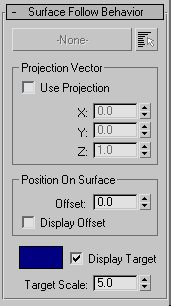 Command entry:
Command entry:  Create panel
Create panel 
 (Helpers)
(Helpers)  Object Type rollout
Object Type rollout  Crowd
Crowd  Setup rollout
Setup rollout  Behaviors group
Behaviors group  Click the New button.
Click the New button.  Select Behavior Type dialog
Select Behavior Type dialog  Surface Follow Behavior
Surface Follow Behavior
The Surface Follow behavior moves delegates with respect to object surfaces, which can be still or animated. For example, you can apply an animated Noise modifier to a patch grid to simulate a choppy water surface, and objects guided by Surface Follow will stay on top.

Specifies a single "target" object to use as a surface. Click this button, and then click the target object in the viewport. The target name then appears on the button.
If you've selected multiple targets using Multiple Selection (see next item), the word Multiple appears on the button. To see which objects are designated as targets, click the Multiple Selection button. The Select dialog appears with designated targets highlighted.
These controls let you override the default direction calculated by the Surface Follow behavior by describing a virtual plane along which the delegate is to move. You do this by specifying a vector, in world coordinates, that's perpendicular to the desired virtual plane.
For example, if you want the delegate, when it encounters a hill, to keep moving forward, straight up and over the hill, instead of skirting it, you would use the default Projection Vector settings: X=Y=0, Z=1. This vector is aligned with the world Z (vertical) axis, so it specifies a plane parallel to the world XY plane. Thus, the delegate always moves straight ahead while following the surface.
Specifies a vector using world coordinates. Default=X=Y=0, Z=1. Range=-1.0 to 1.0.
If only one of these settings is not 0, then the projection vector is aligned with the non-zero axis. Combine non-zero settings to create angled planes for Surface Follow. For example, to create a virtual plane that's rotated 45 degrees clockwise about world Y axis, set X=Z=1 and Y=0. Also, while you can set all three axes to 0, that specifies no vector, and so effectively turns off Use Projection.
When on, the interim goal for each delegate influenced by the Surface Follow behavior is drawn in the viewports as a wireframe sphere during the simulation solution.
If the delegate starts out away from the surface to be followed, the target is most visible before the delegate reaches the surface; the target is then positioned along the surface edge. While the delegate is actually following the surface, the target is usually coincident with the delegate, because Surface follow sets a new destination only a frame or two ahead.